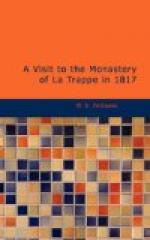“Being descended from the Kings of France, he became the heir to that Kingdom; but as he was educated a Protestant, his claim was resisted. He early distinguished himself by feats of arms. After the peace of Saint Germain, in 1570, he was taken to the French Court, and two years afterwards married Margaret, sister of Charles IX. (At the rejoicings on this occasion the infamous massacre of La Saint Barthelemy took place.) In 1589 he succeeded to the throne of France; but his religion proving an obstacle to his coronation, he consented to abjure it in 1593. In 1598 he issued the edict of Nantes, granting toleration to the Protestants”.
Mezeray, speaking of the marriage of the King of Navarre (afterwards Henry IV.) with Margaret de Valois, says, “There were many diversions, tournaments, and ballets at Court; and amongst others, one which seemed to presage the calamity that was so near bursting out upon the Huguenots—the King and his brothers defending Paradise against the King of Navarre and his brothers, who were repulsed and banished to Hell;” and Sainte Foix, in his relation of the horrible massacre, gives a detail, which in the present age appears almost incredible.
Catherine of Medicis, whose abominable politics had corrupted the disposition of her son, was at the head of the cabinet council who agreed to the murder of more than one hundred thousand Protestants; and the miserable bigot Charles IX. stationed during the massacre at the window of a house then belonging to the Constable of Bourbon, fired with his own hands upon the Huguenots with a long blunderbuss, whilst they were trying to escape across the river.
The River Erdre runs northward of the city, and forms a beautiful feature, winding for many miles among cultivated fields and woodlands, through a country agreeably diversified with villas, to which the wealthier inhabitants retire during the summer months. The river resembles a lake for the greater part of its course, and is called the Barban.
The Gothic church of Saint Pierre, built by the English in 1434, is a fine old structure: having been much neglected for many years, and greatly defaced during the Revolution, it was at this time restoring. Among the monuments about to be replaced, was an excellent one of Anne de Bretagne, whose effigy, and that of her husband, are as large as life. The allegorical figures of Justice, Temperance, Prudence, and Fortitude, the twelve Apostles, and the supporters to the Arms (a greyhound and a lion), are all executed in the finest white marble. They were hidden during the Revolution, and have only very lately been discovered, as have also some capital paintings piously preserved for the Church. Anne was first married to Charles VIII. in 1499, and afterwards to Louis XII. She died at the Chateau de Blois in 1514, and Louis in 1515.




